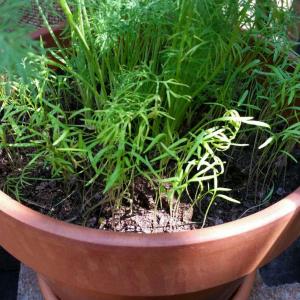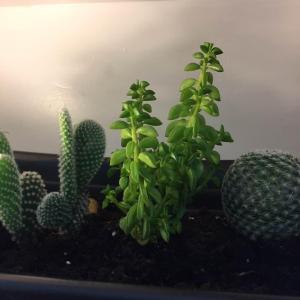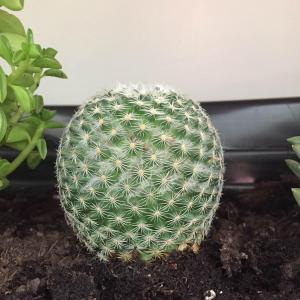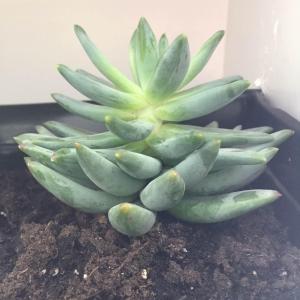文章
Dummer. ゛☀
2017年07月25日

Family - Bignoniaceae
Stems - Woody, climbing or clambering, multiple from base, forming aerial rootlets. New seasons growth glabrous, green.

Leaves - Opposite, petiolate, odd-pinnate, with +/-11 leaflets. Petiole and rachis glabrous or with a few cilia near the base of the leaflets, with a narrow adaxial groove, green. Leaflets opposite, ovate, acuminate, coarsely and irregularly serrate, glabrous above, sparsely pubescent on veins below, acute to acuminate, to +6cm long, +4cm broad. Leaf tissue abruptly contracted and deccurent on petiolule.

Inflorescence - Terminal corymbs of +/-10 flowers. Pedicels to 1.7cm long, subtended by small linear bracts. Pedicel also often with two small scalelike bracts near middle.
Flowers - Corolla red-orange, orange, or yellow, to +/-7cm long, 2cm in diameter, funnelform, 5-lobed at apex, zygomorphic, glabrous. Lobes suborbicular, to 2.5cm broad, 1.5cm long. Stamens 5 (4 + 1), didynamous, included, adnate at contracted portion of corolla tube. Filaments to +3cm long, glabrous, pale yellow. Anthers tan, 5-6mm long. Small stamen with filament to 1.8cm long. Style 1, 4.8cm long, glabrous, yellow-green. Stigma flattened, spatulate, to 3mm broad. Ovary superior, 8mm long, subterete to weakly 6-angled. Placentation axile. Ovules many, glabrous. Calyx tube to +2cm long, reddish, 5-lobed. Lobes 8mm long, acute, 5-6mm broad at base, glabrous internally and externally. Capsules 2-valved, to +15cm long, beaked, woody. Seeds winged.

Flowering - May - August.
Habitat - Open woods, thickets, fence rows, waste ground, disturbed sites, roadsides, railroads. Also cultivated.
Origin - Native to U.S.
Other info. - This striking species is common throughout Missouri but is actually native to only the Ozark section of the state. This is an easily identified vine because of its opposite, pinnate leaves and big, orange flowers. It can frequently be seen growing along fence rows and in waste places.
C. radicans can be aggressive if unchecked and some people are mildly allergic to the plant.
Stems - Woody, climbing or clambering, multiple from base, forming aerial rootlets. New seasons growth glabrous, green.

Leaves - Opposite, petiolate, odd-pinnate, with +/-11 leaflets. Petiole and rachis glabrous or with a few cilia near the base of the leaflets, with a narrow adaxial groove, green. Leaflets opposite, ovate, acuminate, coarsely and irregularly serrate, glabrous above, sparsely pubescent on veins below, acute to acuminate, to +6cm long, +4cm broad. Leaf tissue abruptly contracted and deccurent on petiolule.

Inflorescence - Terminal corymbs of +/-10 flowers. Pedicels to 1.7cm long, subtended by small linear bracts. Pedicel also often with two small scalelike bracts near middle.
Flowers - Corolla red-orange, orange, or yellow, to +/-7cm long, 2cm in diameter, funnelform, 5-lobed at apex, zygomorphic, glabrous. Lobes suborbicular, to 2.5cm broad, 1.5cm long. Stamens 5 (4 + 1), didynamous, included, adnate at contracted portion of corolla tube. Filaments to +3cm long, glabrous, pale yellow. Anthers tan, 5-6mm long. Small stamen with filament to 1.8cm long. Style 1, 4.8cm long, glabrous, yellow-green. Stigma flattened, spatulate, to 3mm broad. Ovary superior, 8mm long, subterete to weakly 6-angled. Placentation axile. Ovules many, glabrous. Calyx tube to +2cm long, reddish, 5-lobed. Lobes 8mm long, acute, 5-6mm broad at base, glabrous internally and externally. Capsules 2-valved, to +15cm long, beaked, woody. Seeds winged.

Flowering - May - August.
Habitat - Open woods, thickets, fence rows, waste ground, disturbed sites, roadsides, railroads. Also cultivated.
Origin - Native to U.S.
Other info. - This striking species is common throughout Missouri but is actually native to only the Ozark section of the state. This is an easily identified vine because of its opposite, pinnate leaves and big, orange flowers. It can frequently be seen growing along fence rows and in waste places.
C. radicans can be aggressive if unchecked and some people are mildly allergic to the plant.
0
0
文章
Dummer. ゛☀
2017年07月24日

Family - Rosaceae
Stems - To +4m long (tall), erect, climbing or sprawling, woody at least at the base, glabrous to hispid, armed with prickles or not, terete.

Leaves - Alternate, typically 3-foliolate on older growth, 5-foliolate on younger growth. Leaflets elliptic, ovate or oblong, serrate, to +5cm long, 4cm wide, glabrous above, variously pubescent to glabrous below. Petiole and stipules glabrous or glandular pubescent.

Inflorescence - Single flowers or few flowered corymbs from leaf axils.
Flowers - Petals 5, pink (rarely white), to +3cm long. Stamens many. Styles 5, united and protruding from hypanthium. Hypanthium +/-1cm in diameter. Sepals 5, to +1.5cm long, pubescent to glandular pubescent. Flowers fragrant.

Flowering - May - July.
Habitat - Moist ground, thickets, open woods, fence rows, roadsides.
Origin - Native to U.S.
Other info. - This is one of the more common roses found in the state. It seems to prefer a shaded location with neighboring plants for support, but will grow fine in the sun and alone.
The plant is quite variable and Steyermark lists two varieties and five forms of the species, mostly based on leaf pubescence and flower color. I wont go into those here.
Stems - To +4m long (tall), erect, climbing or sprawling, woody at least at the base, glabrous to hispid, armed with prickles or not, terete.

Leaves - Alternate, typically 3-foliolate on older growth, 5-foliolate on younger growth. Leaflets elliptic, ovate or oblong, serrate, to +5cm long, 4cm wide, glabrous above, variously pubescent to glabrous below. Petiole and stipules glabrous or glandular pubescent.

Inflorescence - Single flowers or few flowered corymbs from leaf axils.
Flowers - Petals 5, pink (rarely white), to +3cm long. Stamens many. Styles 5, united and protruding from hypanthium. Hypanthium +/-1cm in diameter. Sepals 5, to +1.5cm long, pubescent to glandular pubescent. Flowers fragrant.

Flowering - May - July.
Habitat - Moist ground, thickets, open woods, fence rows, roadsides.
Origin - Native to U.S.
Other info. - This is one of the more common roses found in the state. It seems to prefer a shaded location with neighboring plants for support, but will grow fine in the sun and alone.
The plant is quite variable and Steyermark lists two varieties and five forms of the species, mostly based on leaf pubescence and flower color. I wont go into those here.
0
0
文章
Dummer. ゛☀
2017年07月24日

Family - Rosaceae
Stems - Woody, erect, branching, to -1m tall but typically seen much less. New growth and last seasons twigs olive green, glabrous, with a few (to moderate) straight needle-like thorns.

Leaves - Alternate, odd-pinnate, stipulate. Stipules to +1cm long, entire, acuminate at the apex, with a few piose hairs and distinct red glands on the margins. Rachis of leaf with a few pilose hairs or glabrous. Leaflets typically 5. Lateral leaflets sessile, terminal leaflet stalked. All leaflets ovate to oblong-lanceolate, serrate, to +/-4cm long, +/-2cm broad, deep green and glabrous adaxially, light green and mostly glabrous abaxially but with a few hairs on the midrib or villous.

Inflorescence - Terminal single flower on new seasons growth. Pedicel to +/-1cm long, with a few stalked glands.
Flowers - Fragrant. Petals 5, pinkish, glabrous, distinct, spreading, to +2.5cm long, +2cm broad at the apex, emarginate to notched at the apex. Stamens many (+50), spreading. Filaments yellow, glabrous, to 8mm long. Anthers yellow, to 3mm long. Carpels many, with yellow stigmas, slightly exserted from the hypanthium, densely pubescent. Sepals 5, reflexed in flower, long-attenuate, with moderate glandular and arachnoid pubescence abaxially, to -2cm long, with moderate white arachnoid pubescence adaxially and on the margins. Hypanthium green (light), with few to many stalked glands.

Flowering - May - June.
Habitat - Open woods, glades, prairies, thickets, clearings, roadsides, railroads.
Origin - Native to U.S.
Other info. - This is a common species found throughout Missouri. The plant is variable in flower size, leaflets shape, and leaf pubescence. It grows well from seed and would make a good garden subject. Although there are approximately 15 species of roses growing wild in Missouri, this species and another, R. setigera Michx., make up the bulk of the native rose flora in the state.
Stems - Woody, erect, branching, to -1m tall but typically seen much less. New growth and last seasons twigs olive green, glabrous, with a few (to moderate) straight needle-like thorns.

Leaves - Alternate, odd-pinnate, stipulate. Stipules to +1cm long, entire, acuminate at the apex, with a few piose hairs and distinct red glands on the margins. Rachis of leaf with a few pilose hairs or glabrous. Leaflets typically 5. Lateral leaflets sessile, terminal leaflet stalked. All leaflets ovate to oblong-lanceolate, serrate, to +/-4cm long, +/-2cm broad, deep green and glabrous adaxially, light green and mostly glabrous abaxially but with a few hairs on the midrib or villous.

Inflorescence - Terminal single flower on new seasons growth. Pedicel to +/-1cm long, with a few stalked glands.
Flowers - Fragrant. Petals 5, pinkish, glabrous, distinct, spreading, to +2.5cm long, +2cm broad at the apex, emarginate to notched at the apex. Stamens many (+50), spreading. Filaments yellow, glabrous, to 8mm long. Anthers yellow, to 3mm long. Carpels many, with yellow stigmas, slightly exserted from the hypanthium, densely pubescent. Sepals 5, reflexed in flower, long-attenuate, with moderate glandular and arachnoid pubescence abaxially, to -2cm long, with moderate white arachnoid pubescence adaxially and on the margins. Hypanthium green (light), with few to many stalked glands.

Flowering - May - June.
Habitat - Open woods, glades, prairies, thickets, clearings, roadsides, railroads.
Origin - Native to U.S.
Other info. - This is a common species found throughout Missouri. The plant is variable in flower size, leaflets shape, and leaf pubescence. It grows well from seed and would make a good garden subject. Although there are approximately 15 species of roses growing wild in Missouri, this species and another, R. setigera Michx., make up the bulk of the native rose flora in the state.
0
0
文章
Dummer. ゛☀
2017年07月24日

Family - Fabaceae
Stems - To +3m tall, woody, typically multiple but sometimes simple. All but the oldest wood densely hispid. New growth glandular-hispid.

Leaves - Alternate, odd-pinnate, to +30cm long. Leaflets opposite (sometimes subopposite), glabrous, ovate to oblong, entire, very short-petiolate, mucronate.
Inflorescence - Drooping axillary racemes of +/-10 flowers, to +10cm long. Peduncles and pedicels hispid.
Flowers - Corolla light pink to rose, papilionaceous, to 2.5cm long. Standard to +2cm broad, 1.7cm tall, with yellow spot in center. Stamens diadelphous, tube to 1.4cm long. Anthers yellow-orange, .7mm long. Ovary tuberculate, becoming hispid in fruit, to 1.3cm long. Style upcurved, 6mm long. Stigma elongated, 3-4mm long. Calyx campanulate, bilabiate, hispid. Upper lip with two lobes. Lobes to 3.5mm long, attenuate. Lower lip 3-lobed. Lobes attenuate, to 5mm long. Fruits densely hispid, to +/-8cm long.

Fruit -
Flowering - May - June.
Habitat - Cultivated and rarely escaped to open woods, slopes, and open thickets.

Origin - Native to the southern U.S.
Other info. - This is a very striking plant not only for the flowers but also for the fruits and twigs. The plant is fairly common in cultivation. It can be identified by its pinkish flowers, bristly twigs, and shrubby habit.
Stems - To +3m tall, woody, typically multiple but sometimes simple. All but the oldest wood densely hispid. New growth glandular-hispid.

Leaves - Alternate, odd-pinnate, to +30cm long. Leaflets opposite (sometimes subopposite), glabrous, ovate to oblong, entire, very short-petiolate, mucronate.
Inflorescence - Drooping axillary racemes of +/-10 flowers, to +10cm long. Peduncles and pedicels hispid.
Flowers - Corolla light pink to rose, papilionaceous, to 2.5cm long. Standard to +2cm broad, 1.7cm tall, with yellow spot in center. Stamens diadelphous, tube to 1.4cm long. Anthers yellow-orange, .7mm long. Ovary tuberculate, becoming hispid in fruit, to 1.3cm long. Style upcurved, 6mm long. Stigma elongated, 3-4mm long. Calyx campanulate, bilabiate, hispid. Upper lip with two lobes. Lobes to 3.5mm long, attenuate. Lower lip 3-lobed. Lobes attenuate, to 5mm long. Fruits densely hispid, to +/-8cm long.

Fruit -
Flowering - May - June.
Habitat - Cultivated and rarely escaped to open woods, slopes, and open thickets.

Origin - Native to the southern U.S.
Other info. - This is a very striking plant not only for the flowers but also for the fruits and twigs. The plant is fairly common in cultivation. It can be identified by its pinkish flowers, bristly twigs, and shrubby habit.
0
0
文章
Dummer. ゛☀
2017年07月24日

Family - Rosaceae
Stems - A small tree to 10m tall. Trunk to 30cm in diameter. Bark thin (-1cm thick), scaly, narrowly ridged, reddish-brown to brownish-gray. Older twigs with round lenticels, grayish-brown. New season's growth tomentose but quickly becoming glabrate. Previous season's twigs frequently tapering to a point and forming "thorns."

Leaves - Alternate, petiolate, tomentose when new but quickly glabrate. Petioles pilose, to +1.5cm long, frequently with a pair of linear stipules at the base. Stipules to 2mm long. Petioles with an adaxial groove. Blades ovate-lanceolate, crenate to crenate-serrate, green above, lighter below, with a few reddish glands on the midrib adaxially, to +6cm long, +3cm broad, blunt to acute at the apex.
Inflorescence - 1-4 flowers terminating new season's growth. Pedicels to +/-2cm long, sparse to densely pubescent (pilose), green and reddish-green.

Flowers - Petals 5, spreading, pink to white, clawed, 2-2.5cm long total, +/-1cm broad (blade), rounded at the apex. Blade mostly glabrous, claw pilose and with pilose margins. Claw +/-5mm long. Margins of blade slightly erose. Stamens +/-20, well exserted, erect, borne at the apex of the hypanthium. Filaments to +/-1.3cm long, pink to white, glabrous. Anthers yellow to brown, 2mm long. Pollen yellow. Styles 5, borne at the base of the hypanthium, +/-1.3cm long, densely pilose in the basal 1/3, glabrous above, slightly expanded below the stigmas, translucent-white. Stigmas capitate, small. Ovary inferior, 5-carpellate, with 10 ovules. Hypanthium green, glabrous internally and externally, 3-4mm long, campanulate to cupulate, +2mm in diameter. Sepals 5, mostly glabrous and green externally, tomentose internally, subulate, 3-5mm long, to 2mm broad at the base, apiculate.

Flowering - April - May.
Habitat - Lowland and upland woods and thickets of the Crowley Ridge. Also cultivated.
Origin - Native to U.S.
Other info. - This showy species is rare in Missouri and can be found wild in just one county from the bootheel of the state. It is much more common in cultivation and wild in states to the south and east. The plant can be identified by its ovate-lanceolate leaves, glabrous pedicels and hypanthia, whitish-pink flowers, and small fruits.
The fruits of M. angustifolia are eaten by wildlife. Humans use the fruit to make jelly, preserves, and cider. The wood of the plant is hard and tough and is good for making tool handles and small items.
Stems - A small tree to 10m tall. Trunk to 30cm in diameter. Bark thin (-1cm thick), scaly, narrowly ridged, reddish-brown to brownish-gray. Older twigs with round lenticels, grayish-brown. New season's growth tomentose but quickly becoming glabrate. Previous season's twigs frequently tapering to a point and forming "thorns."

Leaves - Alternate, petiolate, tomentose when new but quickly glabrate. Petioles pilose, to +1.5cm long, frequently with a pair of linear stipules at the base. Stipules to 2mm long. Petioles with an adaxial groove. Blades ovate-lanceolate, crenate to crenate-serrate, green above, lighter below, with a few reddish glands on the midrib adaxially, to +6cm long, +3cm broad, blunt to acute at the apex.
Inflorescence - 1-4 flowers terminating new season's growth. Pedicels to +/-2cm long, sparse to densely pubescent (pilose), green and reddish-green.

Flowers - Petals 5, spreading, pink to white, clawed, 2-2.5cm long total, +/-1cm broad (blade), rounded at the apex. Blade mostly glabrous, claw pilose and with pilose margins. Claw +/-5mm long. Margins of blade slightly erose. Stamens +/-20, well exserted, erect, borne at the apex of the hypanthium. Filaments to +/-1.3cm long, pink to white, glabrous. Anthers yellow to brown, 2mm long. Pollen yellow. Styles 5, borne at the base of the hypanthium, +/-1.3cm long, densely pilose in the basal 1/3, glabrous above, slightly expanded below the stigmas, translucent-white. Stigmas capitate, small. Ovary inferior, 5-carpellate, with 10 ovules. Hypanthium green, glabrous internally and externally, 3-4mm long, campanulate to cupulate, +2mm in diameter. Sepals 5, mostly glabrous and green externally, tomentose internally, subulate, 3-5mm long, to 2mm broad at the base, apiculate.

Flowering - April - May.
Habitat - Lowland and upland woods and thickets of the Crowley Ridge. Also cultivated.
Origin - Native to U.S.
Other info. - This showy species is rare in Missouri and can be found wild in just one county from the bootheel of the state. It is much more common in cultivation and wild in states to the south and east. The plant can be identified by its ovate-lanceolate leaves, glabrous pedicels and hypanthia, whitish-pink flowers, and small fruits.
The fruits of M. angustifolia are eaten by wildlife. Humans use the fruit to make jelly, preserves, and cider. The wood of the plant is hard and tough and is good for making tool handles and small items.
0
0
成长记
Ueca
2017年07月24日

Potted them so I can study their growth, and to prevent slugs from chewing the sprouts.
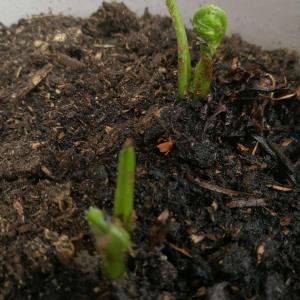

1
0
文章
Dummer. ゛☀
2017年07月22日

Family - Ericaceae
Stems - To +60cm tall, typically some shade of green and without a great deal of bark except at very base, branching, erect to ascending(in young stems), twigs and new growth pubescent to tomentose, stoloniferous, shrubby.

Leaves - Alternate, short-petiolate. Petioles to 2-3mm long, pubescent. Blades elliptic to obovate, short-acute to short-acuminate, glabrous to pubescent and green above, tomentose and glaucous below, to +3cm long, +2cm broad. Margins appearing entire but actually crenulate-serrulate(especially in younger leaves), often reddish at very edge of margin.
Inflorescence - Flowers appearing with the new seasons leaves from terminal and axillary buds. Racemes to 1.5cm long in flower, longer in fruit. Bracts subtending pedicels obovate, to +/-3mm long, with small mucro tip, cupped. Small pair of bractlets on base of pedicel to -3mm long, glabrous, with a few cilia on margins or not, lanceolate, acuminate.
Flowers - Corolla urceolate to cylindric, 5-6mm long, 4mm in diameter, glabrous, white or with some pink, 5-lobed. Lobes recurved, acute, 1.1mm long. Stamens 10, included. Filaments compressed, antrorse pubescent, 2mm long, greenish-white. Anthers copper-colored, 2-lobed, 2mm long. Style green, included, 5mm long, glabrous. Ovary inferior, 2-locular. Calyx tube 1.7mm long, 5-lobed, glabrous, green. Lobes shallow, rounded, light green, 1mm long. Berries globose, glaucous, blue-purple, 5-6mm in diameter, tasty.

Flowering - April - May.
Habitat - Dry rocky open woods, ledges, bluffs, glades, ridges, typically in acid soil.
Origin - Native to U.S.
Other info. - This small, shrubby species is common in the lower 1/2 of Missouri. The plant produces a tasty blueberry in the summer which is enjoyed by wildlife as well as people. The plant is distinguishable from the two other Missouri blueberries by the fact that it is the smaller of the 3 species, it has leaves which are glaucous below, and the stems are typically mostly herbaceous and some shade of green. The other two species of Vaccinium in Missouri become woody very early on in their growth.
A synonym for this species is V. pallidum Ait.
When small and immature, the 3 species of Vaccinium in Missouri can be difficult to differentiate in the field. The best way to tell the species apart is by looking at the leaf venation. The venation of V. arboreum is spaced widely apart. The venation of V. vacillans is spaced fairly close together. The veins of V. stamineum are very close together and sometimes hard to see. In the photo below, the venation of all three species is shown. From left to right the species are V. arboreum, V. stamineum and V. vacillans.
Stems - To +60cm tall, typically some shade of green and without a great deal of bark except at very base, branching, erect to ascending(in young stems), twigs and new growth pubescent to tomentose, stoloniferous, shrubby.

Leaves - Alternate, short-petiolate. Petioles to 2-3mm long, pubescent. Blades elliptic to obovate, short-acute to short-acuminate, glabrous to pubescent and green above, tomentose and glaucous below, to +3cm long, +2cm broad. Margins appearing entire but actually crenulate-serrulate(especially in younger leaves), often reddish at very edge of margin.
Inflorescence - Flowers appearing with the new seasons leaves from terminal and axillary buds. Racemes to 1.5cm long in flower, longer in fruit. Bracts subtending pedicels obovate, to +/-3mm long, with small mucro tip, cupped. Small pair of bractlets on base of pedicel to -3mm long, glabrous, with a few cilia on margins or not, lanceolate, acuminate.
Flowers - Corolla urceolate to cylindric, 5-6mm long, 4mm in diameter, glabrous, white or with some pink, 5-lobed. Lobes recurved, acute, 1.1mm long. Stamens 10, included. Filaments compressed, antrorse pubescent, 2mm long, greenish-white. Anthers copper-colored, 2-lobed, 2mm long. Style green, included, 5mm long, glabrous. Ovary inferior, 2-locular. Calyx tube 1.7mm long, 5-lobed, glabrous, green. Lobes shallow, rounded, light green, 1mm long. Berries globose, glaucous, blue-purple, 5-6mm in diameter, tasty.

Flowering - April - May.
Habitat - Dry rocky open woods, ledges, bluffs, glades, ridges, typically in acid soil.
Origin - Native to U.S.
Other info. - This small, shrubby species is common in the lower 1/2 of Missouri. The plant produces a tasty blueberry in the summer which is enjoyed by wildlife as well as people. The plant is distinguishable from the two other Missouri blueberries by the fact that it is the smaller of the 3 species, it has leaves which are glaucous below, and the stems are typically mostly herbaceous and some shade of green. The other two species of Vaccinium in Missouri become woody very early on in their growth.
A synonym for this species is V. pallidum Ait.

When small and immature, the 3 species of Vaccinium in Missouri can be difficult to differentiate in the field. The best way to tell the species apart is by looking at the leaf venation. The venation of V. arboreum is spaced widely apart. The venation of V. vacillans is spaced fairly close together. The veins of V. stamineum are very close together and sometimes hard to see. In the photo below, the venation of all three species is shown. From left to right the species are V. arboreum, V. stamineum and V. vacillans.
0
0
成长记
meriunkat
2017年07月22日

Anyone have an idea what kind of succulents these might be? they don't grow very much, i believe some have reached there full growth size. I took them out feom under bolders on the Lake Tahoe hiking trails.
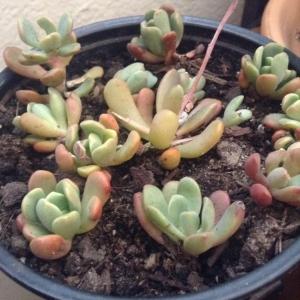

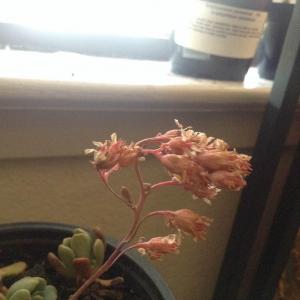



2
0
Abby Gill:My guess is sedum pachyphyllum, but don't take my word for it.



